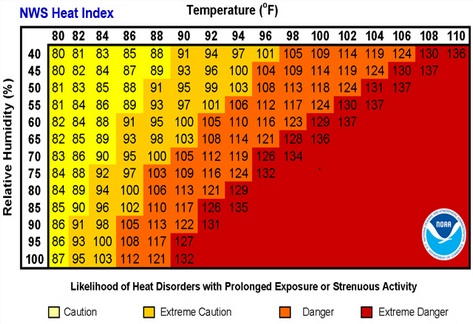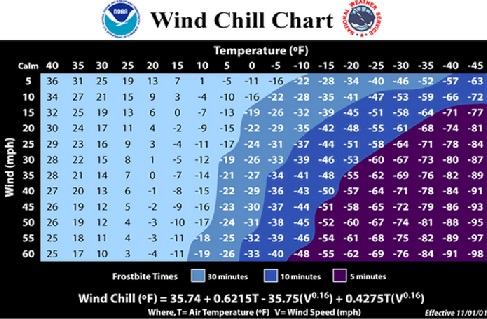Posted On: Thursday - August 17th 2023 9:51PM MST
In Topics: Global Climate Stupidity Science
This post is sort of a continuation of our post Feels Like .. a bunch of more lies. That one was more about just one more type of lying seen in the weather reports as part of the push for the narrative of what's now dubbed Global Boiling. Here, rather than rail on those lying via the use of "Real Feel" or "Feels like" for false comparisons in weather reports, we'll expound more on the legitimate science behind the Heat Indices for hot weather and Wind Chills for cold.
Both the charts in this post come from the National Weather Service. I'm sure there are areas of Wokeness within this Feral Gov't department, but I assume there are normal working people trying to disseminate good weather data too.

The table is simple. Only the relative humidity is used with (dry-bulb, aka, standard) temperature values to come up with heat index values. Relative humidity = the amount of water in the air / the amount of water the air could hold when saturated at that temp. Note some numbers: At 80F, a RH change from 50% to 100%, twice the amount of water in the air (at 80F) only results in a "feel" of 6F higher. At 90F, that same change results in a "feel" of 37F higher. What a difference! How did the NWS actually come up with these values for comparison of how it "feels" outside?
Remember, our bodies' feel of temperature is more based on the rate of heat transfer to/from it than on the temperature itself. In warm temperatures, humans sweat as one way to transfer heat. (Otherwise we'd have to pant like dogs - kind of embarrassing.). How we sweat explains the heat index. In dry air, the moisture out of our pores evaporates quickly, cooling us but not staying long on our skin.* In humid air, the moisture will be absorbed more slowly, and that layer of sweat on our skin makes us miserable just by being there, and it also impedes heat transfer with resistance to transfer from the skin to the sweat layer, through the sweat layer, and from the outside of it to the air.
How exactly the numbers here are determined is unknown to me. (I'm sure someone can look it up.). Each of our bodies is different however, and I think there's no way this chart applies to each of us equally. It's a rough guide, but it's missing other factors.

Note the formula on the bottom that is obviously empirical, what with that 0.16 exponent and all.
The Wind Chill values are only factors of dry bulb temperature and the wind speed. Well, yeah, convection heat transfer from our skin, as from any other surface, goes way up with the speed of the fluid flow around it. Analysis of "natural", or "free" convection, meaning convection only due to natural buoyancy effects of warmer air vs colder, uses completely different empirical formulae than those used for "forced" convection. The physics that result in the wind chill values are somewhat simpler than that which results in the sweaty Heat Index values.
Still, is there not a humidity factor in the cold too and a forced convection factor in the heat? Yes. Commenter Jimbobla brought up the heating effect felt in the wind on very hot days. "Very hot" in his case means temperatures higher than skin temperature, which I'd read is around 92F. Above that, the forced convection will transfer more heat TO the body. It's not THAT simple, as our skin temperature will rise and various equilibria will be reached.
As for humidity effects in the cold weather, we may have all experienced the more miserable weather in the wet fairly cold climates that seems worse than 10F lower in the dry air. It's not about sweat here, as we're bundled up, and it's only the face and hands exposed. What is the factor that gives the damp place a "real feel" of "sucky"? Mr. Anon gave an explanation:
It's also important because a very large fraction of the heat capacity, and a significant fraction of the thermal conductivity, of air is due to the water vapor. That's why low thirties (but above 32 deg. F) can feel a lot colder than high twenties. Above freezing the air has some water vapor in it that can more effectively pull heat out of you (hence the "bone-chilling" damp cold). Below freezing, the air is dry and is a relatively good insulator (if it's not blowing on you).The amount of water the air can hold is a continuous function, down below freezing too. It's not just about the freezing point, but about the humidity the air can hold. Check out this psychrometric chart with F temps., along with this rougher version with C temps, the latter having the Absolute Humidity (sometimes appropriately called "Humidity Ratio") in better units, lb/lb. Note that below 40 F (4C) saturated (100% RH) air only holds 0.5% water, while 85 F air (30C) can hold over 3% water on a mass basis.**
The importance of water vapor in the air is significant at cold temperatures, but we don't have as much skin exposed and the air can't hold nearly the amount of water it does on the days during which we worry about the Heat Index. Should it not be taken into account, though, requiring a 3-D chart for a "Cold Index" dependent on 3 variables? That's just as the "Heat Index" could use the same, with wind speed as another independent variable.
Yeah, it's complicated. Actually, it's more complicated. After all, another reason Denver, Colorado (elevation not even taken into account) on a 20F day may feel lots nicer than Boston, Mass on a 35F day is the sunshine and lack thereof, respectively. The difference in radiation heat transfer is significant. "Sunshine on my shoulder makes me happy", said John Denver, a promoter of Rocky Mountain high Colorado. Maybe some dope had something to do with this too, but for "feels like" readings, well, we're running out of dimensions here!
So, whaddya' do, take readings of all these climate factors, leaving the pot intake out of it, and then come up with some conglomeration variable called "True Feel"? Sunshine may change hourly and is not that predictable. Wind speed is more predictable, but it varies over the day too almost as much as sunshine. This True Feel would not be some solid number for the day.
Forget it. Just give me a decent temperature and precip forecast, so we can dress in layers, go outside, and enjoy the planet before Global Boiling starts in earnest.
* Commenter Jimbobla had a good point on this in the comments under that previous post:
Hot dry air (high 90’s) will have similar, if opposite, heat index effect on your body. Pulling moisture off your skin before it can perform its cooling function through evaporative cooling.** That left side boundary curve represents saturated air, or the 100% relative humidity curve.
Comments:
Jimbobla
Saturday - August 19th 2023 10:19AM MST
PS Yea, you start factoring in all the variables and I can’t imagine what a chart would look like. All I really remember about wind chill is when I was under my truck at -40 something degrees and the wind howling, trying to get my starter to work, I wasn’t looking for a chart. I was just wondering if I could get the starter unfrozen before I became a statistic. I worked in an underground mine where the rock temperature at the 7200 ft level in 11 ledge was somewhere around 132 F. If you got too far from the vent bag you would start having anxiety attacks. Again, I don’t remember thinking about what a chart would tell me.
Jimbobla
Saturday - August 19th 2023 10:19AM MST
PS Yea, you start factoring in all the variables and I can’t imagine what a chart would look like. All I really remember about wind chill is when I was under my truck at -40 something degrees and the wind howling, trying to get my starter to work, I wasn’t looking for a chart. I was just wondering if I could get the starter unfrozen before I became a statistic. I worked in an underground mine where the rock temperature at the 7200 ft level in 11 ledge was somewhere around 132 F. If you got too far from the vent bag you would start having anxiety attacks. Again, I don’t remember thinking about what a chart would tell me.
Moderator
Friday - August 18th 2023 7:49AM MST
PS: Yeah, also not a big fan of anything on wiki either unless it's straight simple facts, Jombobla, and this stuff may even get political! I'll read it, but I don't see how those variables can be included unless you plot this corrected heat index by the minute (nearly) and in very specific spots.
So, they can't be included if you're going to give one number for this afternoon or yesterday's value, etc, hence the inaccuracy of the Heat Index (and Wind Chill) as a number that truly records how a human will feel relative to in other conditions, and not to mention as compared to other people who's bodies are different.
So, they can't be included if you're going to give one number for this afternoon or yesterday's value, etc, hence the inaccuracy of the Heat Index (and Wind Chill) as a number that truly records how a human will feel relative to in other conditions, and not to mention as compared to other people who's bodies are different.
Jimbobla
Friday - August 18th 2023 7:23AM MST
PS There should be included in the heat index the variables of both wind and direct sunlight. Though not a fan of Wiki, check them out on heat index. They address the lack of those variables.